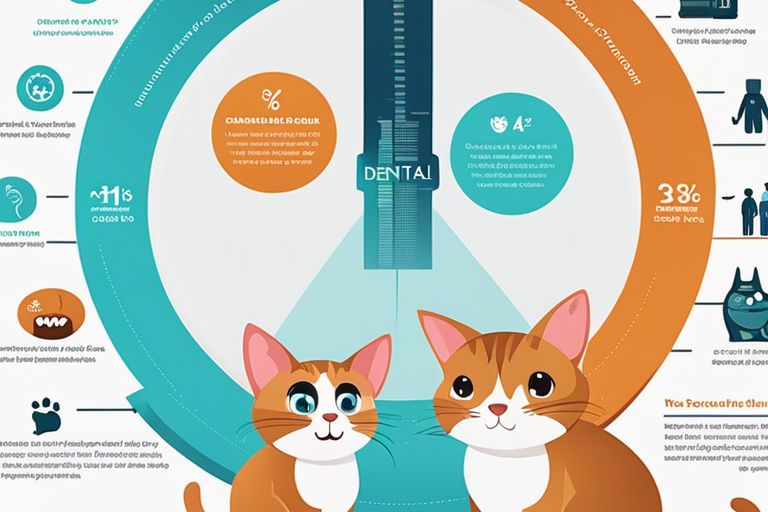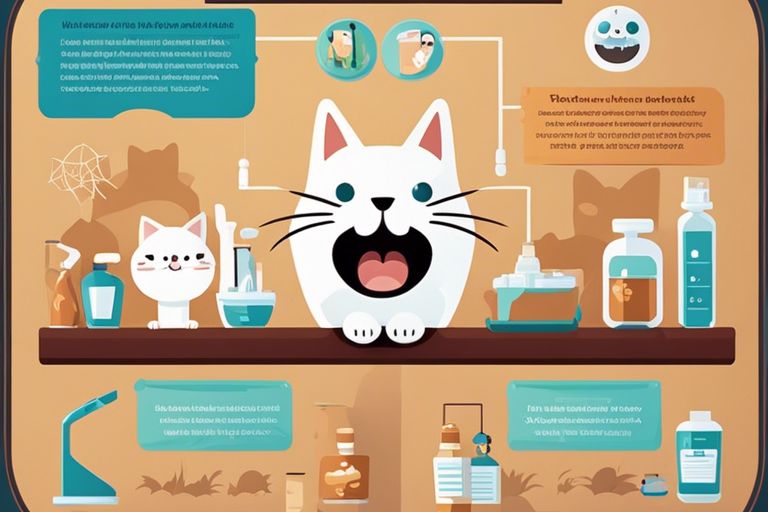Many feline owners are often unaware of the importance of maintaining their cat’s dental health. However, neglecting your cat’s dental care can lead to a myriad of issues that can jeopardize their overall health and well-being. Some of the most common dental problems in cats include periodontal disease, tooth resorption, and gingivitis. Without proper care, these dental problems can cause pain, discomfort, and even lead to more severe concerns such as heart, liver, and kidney issues. It is essential to be aware of these potential problems and take the necessary steps to ensure your cat’s dental health.
Key Takeaways:
- Dental disease is common in cats: Cats can suffer from a range of dental problems including gingivitis, periodontal disease, and tooth resorption. It is important to monitor their dental health regularly.
- Plaque and tartar buildup: Many cats suffer from plaque and tartar buildup which can lead to dental problems and the need for professional dental cleanings.
- Signs of dental issues: Look out for symptoms such as bad breath, difficulty eating, drooling, and pawing at the mouth, as these can indicate dental problems in cats.
- Preventive care is crucial: Regular tooth brushing, dental diets, and dental treats can help prevent dental problems in cats. It is important to establish a good dental care routine from an early age.
- Veterinary dental check-ups: Regular dental check-ups with a veterinarian are essential for maintaining your cat’s oral health and addressing any potential dental issues early on.
Common Dental Problems in Cats
Clearly, maintaining your cat’s dental health is important for their overall well-being. Cats are prone to various dental issues, which can lead to discomfort, pain, and potential health complications if left untreated. Understanding the most common dental problems in cats can help you identify and address issues early, ensuring your feline friend’s oral health. For more information, you can also refer to Dental Disease in Cats.
Periodontal Disease
Periodontal disease, also known as gum disease, is one of the most prevalent dental problems in cats. It occurs when plaque and tartar build-up along the gum line, leading to inflammation and infection. If left untreated, periodontal disease can result in tooth loss and may even affect your cat’s overall health. Regular dental care and professional cleanings can help prevent and manage this condition. It’s essential to monitor your cat’s dental health and address any signs of periodontal disease promptly to prevent further complications.
Tooth Resorption
Tooth resorption is a common, yet painful dental condition in cats, where the structures of the tooth are broken down and absorbed by the body. This process can cause intense discomfort for your cat, leading to difficulty eating and grooming. Unfortunately, tooth resorption often goes unnoticed as cats can be adept at hiding signs of pain. Detection and treatment by a veterinarian are crucial for managing this condition. If you notice any changes in your cat’s eating habits or signs of oral discomfort, it’s important to seek veterinary care promptly to address tooth resorption.
Stomatitis
Stomatitis is a severe and painful inflammation of the mouth and gums in cats. This condition can cause significant discomfort, leading to difficulty eating and grooming. Stomatitis is often linked to dental plaque and tartar accumulation, as well as a cat’s immune response to these oral bacteria. In severe cases, professional dental treatment, and medications may be necessary to manage stomatitis. Accurate diagnosis and timely intervention are essential for maintaining your cat’s comfort and oral health when dealing with stomatitis.
Fractured Teeth
Fractured teeth can occur in cats due to various reasons, including trauma, chewing on hard objects, or advanced dental disease. A fractured tooth can be painful and may expose the sensitive inner layers of the tooth, leading to potential infection and discomfort. Seeking veterinary care is crucial if you suspect your cat has a fractured tooth, as it may require extraction or other dental treatment. Regular dental check-ups and prompt treatment of fractured teeth are essential for preventing further pain and complications for your cat.
Diagnosis and Detection
Not all dental issues in cats are immediately obvious. Your cat may be experiencing discomfort or pain without showing any obvious signs. Regular dental check-ups and examinations are crucial for detecting and diagnosing any potential dental problems early on.
Symptoms of Dental Issues in Cats
When it comes to dental issues in cats, it’s important to pay attention to any changes in their behavior or eating habits. Common symptoms of dental problems in cats include bad breath, difficulty chewing or red and swollen gums. You may also notice your cat drooling excessively or pawing at their mouth. Keep an eye out for any changes in appetite or disinterest in chew toys or crunchy treats. If you notice any of these symptoms, it’s important to schedule a dental examination with your veterinarian as soon as possible.
Professional Dental Examinations
Regular professional dental examinations are essential for maintaining your cat’s oral health. Your veterinarian will perform a thorough examination of your cat’s teeth, gums, and mouth to check for any signs of dental problems. They may also recommend dental X-rays to assess the health of your cat’s teeth and roots. Additionally, your veterinarian can provide professional cleaning to remove any plaque and tartar buildup. Professional dental examinations are the best way to catch and address any dental issues before they become more serious.

Prevention and Treatment
Unlike humans, cats do not have the best reputation for cooperating when it comes to dental care. However, there are several preventive measures you can take to ensure your cat’s oral health. By implementing these techniques, you can help to reduce the risk of common dental problems and keep your feline friend’s teeth and gums healthy.
Daily Oral Hygiene Techniques
One of the most effective ways to prevent dental problems in your cat is by implementing daily oral hygiene techniques. This can include brushing your cat’s teeth with a specially designed toothbrush and toothpaste. Additionally, there are dental treats and toys available that can help to reduce the buildup of plaque and tartar on your cat’s teeth. By making these techniques a part of your daily routine, you can significantly decrease the likelihood of your cat developing dental issues.
Professional Dental Cleanings and Procedures
While daily oral hygiene is essential, it is also important to schedule regular professional dental cleanings and procedures for your cat. Your veterinarian can perform a thorough dental examination and cleaning to address any existing dental problems and prevent new ones from developing. In some cases, dental procedures such as extractions or root canals may be necessary to treat advanced dental issues. By working with your veterinarian, you can ensure that your cat receives the necessary professional care to maintain their oral health.
Most Common Dental Problems in Cats
On the whole, it’s important to be aware of the most common dental problems that can affect your feline companion. Regular dental check-ups and at-home care are crucial in preventing and addressing issues such as periodontal disease, plaque and tartar buildup, tooth resorption, and broken or fractured teeth. By staying proactive and attentive to your cat’s oral health, you can help ensure their overall well-being and quality of life. Remember to consult with a veterinarian for personalized guidance on how to best care for your cat’s dental health.
FAQ
Q: What are the most common dental problems in cats?
A: The most common dental problems in cats include periodontal disease, tooth resorption, and stomatitis. Periodontal disease is caused by the buildup of plaque and tartar, leading to inflamed gums and potential tooth loss. Tooth resorption is a painful condition in which the tooth structure is gradually broken down. Stomatitis is a severe inflammation of the mouth and gums, often causing extreme discomfort for the affected cat.
Q: How can I tell if my cat has dental problems?
A: Signs of dental problems in cats can include bad breath, drooling, reluctance to eat, pawing at the mouth, and visible tartar or redness along the gumline. Some cats may also become more irritable or reclusive due to the discomfort associated with dental issues. Regular veterinary check-ups, including dental examinations, are essential for early detection of potential problems.
Q: How can I prevent dental problems in my cat?
A: Proper dental care is essential for preventing dental problems in cats. This includes regular brushing of your cat’s teeth with a pet-friendly toothpaste, providing dental treats or toys designed to reduce plaque and tartar buildup, and scheduling regular dental cleanings with your veterinarian. Additionally, feeding a balanced diet and avoiding excessive treats or table scraps can contribute to better overall dental health for your cat.

Jayley, a devoted cat enthusiast, also writer for other cat blog as well. She aims to dedicated to providing comprehensive information, insights, and advice on everything you’d ever want to know about our whiskered companions.
